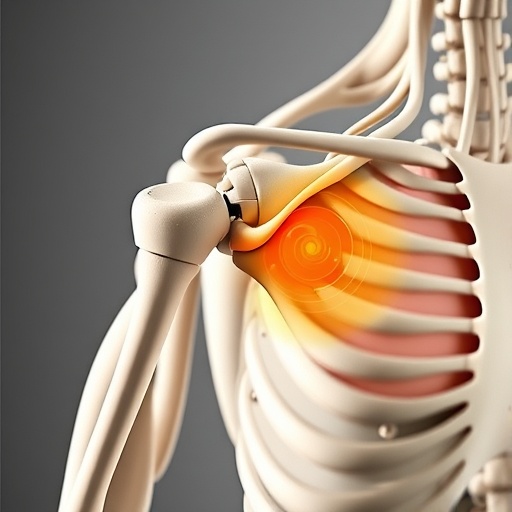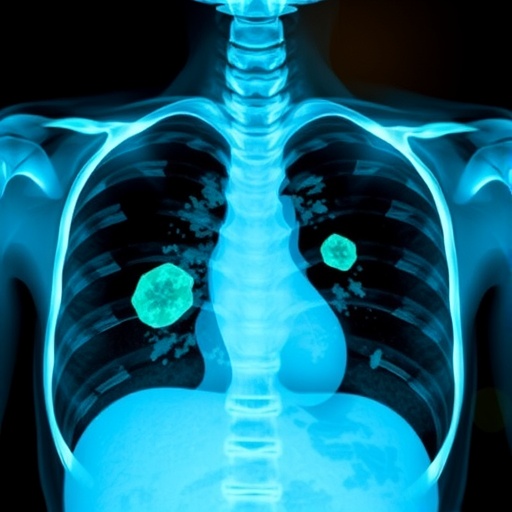
The intricate mechanics of the shoulder have long fascinated biomechanical researchers and clinicians alike, owing to the joint’s remarkable range of motion and complex muscular interplay. Among the critical components contributing to shoulder function is the rotator cuff, a group of muscles and tendons that stabilize the humeral head within the glenoid cavity. Recent research has delved deeper into how humeral rotation influences strain patterns and loading within the rotator cuff, revealing new insights that may have profound implications for understanding shoulder injuries and their rehabilitation.
In a groundbreaking in vitro study published in BioMedical Engineering OnLine, researchers have explored the biomechanical consequences of constrained versus free humeral rotation during active shoulder elevation. Utilizing twelve fresh-frozen cadaveric shoulders, the study simulated active humeral abduction up to 30°, examining the rotator cuff under varying conditions. This included intact musculature as well as artificially induced tears of different morphologies—crescent-shaped and reverse L-shaped—both at 50% and full thickness levels. The meticulous experimental setup allowed precise measurement of load distribution, strain metrics, and kinematic shifts in real time, painting a comprehensive picture of rotator cuff dynamics.
One of the most pivotal findings highlights that restricting humeral rotation significantly increases the strain experienced by the supraspinatus and infraspinatus muscles. The supraspinatus, a prime shoulder abductor, showed elevated loading forces when rotation was blocked, implying compensatory mechanisms at play to maintain shoulder movement in the face of mechanical constraints. This finding underscores the supraspinatus not only as an abductor powerhouse but also as a critical stabilizer when normal rotational mechanics are disrupted.
.adsslot_iugr2Rn0JU{width:728px !important;height:90px !important;}
@media(max-width:1199px){ .adsslot_iugr2Rn0JU{width:468px !important;height:60px !important;}
}
@media(max-width:767px){ .adsslot_iugr2Rn0JU{width:320px !important;height:50px !important;}
}
ADVERTISEMENT
Moreover, the infraspinatus, which functions as a primary external rotator of the shoulder, exhibited heightened strain at the initial phases of abduction when humeral movement was restricted. This observation elucidates the muscle’s role during early elevation, especially under biomechanical challenges, reinforcing the complex intermuscular coordination required for seamless shoulder function. Researchers infer that this dynamic loading may contribute to varying injury patterns observed clinically, particularly in patients with compromised rotational capacity.
Humeral head kinematics also demonstrated intriguing alterations contingent on the integrity of the rotator cuff and the degree of rotational freedom. Specimens with full-thickness reverse L-shaped tears showed a stark divergent behavior: with free humeral rotation, the head translated posteriorly during elevation, whereas constrained rotation induced anterior translation. Such directional changes could be critical factors in understanding shoulder instability and pathology progression, potentially guiding surgical decisions and rehabilitation protocols tailored to specific tear morphologies.
The range of motion, a vital functional attribute, was notably affected in more than half of the specimens when humeral rotation was blocked. This reduction in mobility likely stems from the altered muscular load distribution and mechanical interplay within the joint capsule. It suggests that even minor restrictions in rotational freedom can significantly impair shoulder flexibility, which might predispose individuals to further injury or chronic dysfunction if not properly addressed.
Interestingly, smaller tears did not universally lead to increased humeral rotation or loading of the infraspinatus. This phenomenon might reflect compensatory mechanisms involving the subscapularis muscle, which could absorb some of the mechanical demands normally placed on the infraspinatus. Such insights hint at the shoulder’s intrinsic adaptability, potentially informing conservative treatment strategies that leverage muscular compensation before embarking on more invasive interventions.
The meticulous choice of tear shapes in the study—crescent-shaped and reverse L-shaped—adds valuable nuance, given that tear geometry profoundly influences mechanical load paths and subsequent tissue strain. By simulating these distinct clinically relevant tear types, the research bridges experimental modeling with real-world orthopedic challenges, enhancing translational relevance.
This study’s innovative use of cadaveric models, while limiting direct clinical extrapolation, provides unparalleled control over variables such as joint positioning and tear size, enabling clear causal inferences about the biomechanical effects of humeral rotation on rotator cuff function. Such precise control is challenging to achieve in vivo due to patient variability and ethical considerations, which amplifies the value of in vitro biomechanical investigations.
The findings also reinforce the concept that the rotator cuff’s multifaceted roles—in abduction, rotation, and stabilization—are interdependent rather than discrete. Disruption in one plane of motion can cascade into compensatory strategies and altered strain patterns, potentially perpetuating a cycle of injury if unchecked. This underscores the necessity of considering the shoulder as an integrated biomechanical system during clinical assessments and in rehabilitative planning.
From a rehabilitative perspective, these insights advocate for therapeutic approaches that restore or preserve humeral rotational freedom to minimize abnormal loading on the rotator cuff muscles. Therapists could incorporate targeted mobility exercises and neuromuscular retraining designed to maintain or improve humeral rotation, thus potentially mitigating strain-related exacerbation of cuff pathology.
Moreover, surgical interventions aiming to repair rotator cuff tears may benefit from strategies that restore not only tendon integrity but also preserve joint kinematics, especially rotational capabilities. The study’s demonstration that blocked rotation leads to detrimental strain patterns highlights the importance of surgical techniques that respect the natural biomechanics of the shoulder, potentially improving postoperative outcomes.
In sum, this investigation spearheads a nuanced understanding of how humeral rotation profoundly impacts rotator cuff loading, strain, and shoulder kinematics. By revealing muscle-specific strain variations and kinematic shifts associated with constrained motion and tear morphologies, it opens avenues for refined diagnostic, surgical, and rehabilitative strategies tailored to individual biomechanical profiles.
Future research building upon these findings could explore dynamic loading scenarios beyond the initial 30° of abduction and incorporate muscular activation patterns via computational modeling or in vivo imaging. Such integrative approaches may unravel the intricacies of neuromuscular coordination under pathological conditions, enhancing the clinical translation of biomechanical principles.
The study’s insights bear direct relevance not only to orthopedic surgeons and physiotherapists but also to those involved in biomechanics research and sports medicine. As shoulder injuries remain prevalent, especially among athletes and the aging population, a deeper biomechanical understanding is paramount to advancing care paradigms and improving quality of life for affected patients.
The contribution of this research lies in its detailed dissection of rotational biomechanics within a clinically significant context, highlighting the intricate balance between muscular loading, tendon strain, and joint motion. This work stands as a vital stepping stone in decoding the complex interplay governing shoulder stability and function.
Subject of Research: Biomechanical effects of humeral rotation on rotator cuff strain, loading, and shoulder kinematics with intact and torn rotator cuff conditions.
Article Title: Effect of humeral rotation on rotator cuff strain, loading and kinematics: an in vitro study
Article References:
Santos, I., Pichler, L., Pietschmann, M.F. et al. Effect of humeral rotation on rotator cuff strain, loading and kinematics: an in vitro study.
BioMed Eng OnLine 24, 74 (2025). https://doi.org/10.1186/s12938-025-01406-4
Image Credits: AI Generated
DOI: https://doi.org/10.1186/s12938-025-01406-4
Tags: active shoulder elevation studiesbiomechanics of shoulder injuriescadaveric shoulder studiesconstrained versus free humeral rotationhumeral rotation effectsrehabilitation implications for rotator cuffrotator cuff injury researchrotator cuff mechanicsrotator cuff tear morphologiesshoulder injury prevention strategiesshoulder joint biomechanicsstrain patterns in rotator cuff





